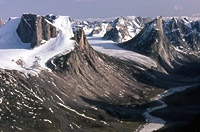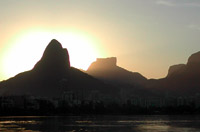
THIS IS NOT THE OFFICIAL ESS 211 WEB SITE FOR AUTUMN 2012**
| ESS 211 home |
| Information |
| Field trip |
| Lecture notes |
| Labs |
| Exams |
| Photos |
| Web resources |
| Google Earth |
| What next in ESS? |
| Footnotes |
| FAQ |



Introduction
Welcome to ESS 211. This is the first of three courses in the 200-level core of the Earth and Space Sciences undergraduate curriculum. As you can tell from the title, the main objective of the course is to teach you about the physical processes that shape and modify the Earth's surface and outer crust. In this regard, the course will introduce you to the disciplines of geomorphology - the study of the evolution of landforms and the Earth's surface, and of structural geology and tectonics - the study of how rocks on all scales, from an outcrop to a mountain range, are deformed. The class will also introduce you to geologic maps, and teach you how to interpret outcrop patterns, identify geologic structures and draw cross-sections.We realize that many students in this class will not have taken a university-level earth science course before, so we will begin with a summary of the Earth's overall structure, age and composition.
Instructors
Prof Darrel Cowan (co-ordinator) Office: 334 Johnson Hall Phone: 543-4033 darrel@u.washington.edu
Prof John Stone Office: 345 Johnson Hall Phone: 221-6332 stn@u.washington.edu
TA: Lab sections AB/AC Samantha Ewing Office: 423 Johnson Hall ewings2@u.washington.edu
TA: Lab section AA Gabe Casale Office: 330 Johnson Hall casale@u.washington.edu Prerequisites
The prerequisite for this course is PHYS 114 (General Physics) or PHYS 121 (Mechanics). PHYS 121 requires previous or concurrent enrollment in MATH 124. You do not need calculus for ESS 211. Those with a little calculus, however, will recognize some familiar equations, and see alternative ways to approach lab and lecture problems.
Class Timetable
Lecture 10:30 - 11:20 M W F 175 Johnson Hall Lab AA 9:30 - 11:20 T Th 011 Johnson Hall Lab AB 11:30 - 1:20 M W F 011 Johnson Hall Lab AC 1:30 - 3:20 M W F 011 Johnson Hall When required, computer-based lab sessions will meet in 021 or 366 Johnson Hall.
Textbooks and recommended reading
Because this course draws material from several geological disciplines, no single textbook provides sufficient coverage. We have chosen not to require multiple textbooks, because we cannot reasonably recommend buying several books costing hundreds of dollars. One optional text that covers Earth structure, tectonics and geomorphology is: "Global Geomorphology" by Mike Summerfield [1996, Prentice Hall].
You may also wish to consult a well-illustrated, introductory earth-sciences text, such as Geology by Chernicoff and Whitney, Physical Geology, by Plummer, McGeary and Carlson, or Earth by Press and Siever, for reading and illustrations that support some of the lecture topics in this course. A wonderful book, though sadly out of print, is Geology Illustrated by John S. Shelton [1966, WH Freeman]. This book contains superb aerial photographs, many of eastern Washington and the western US, accompanied by interpretive drawings and cross-sections. Both this book and Global Geomorphology are on reserve at the Natural Sciences Library.
Syllabus and lab schedule
Please see the lecture schedule on the lecture handouts download page.
Lab topics, schedule and due-dates are listed on the lab materials download page.
Exams and grading policyExams will cover material presented in lectures and laboratory exercises. Exam questions will emphasize concepts and problem-solving rather than memorization. The final exam will be comprehensive, but it will deal primarily with material covered after the mid-term exam.
Midterm exam 30% of your final grade Wednesday 31 October 10:30 - 11:20 am Final exam 35% of your final grade Monday 10 December 8:30 - 10:20 am Lab exercises 35% of your final grade Due dates on the lab schedule
